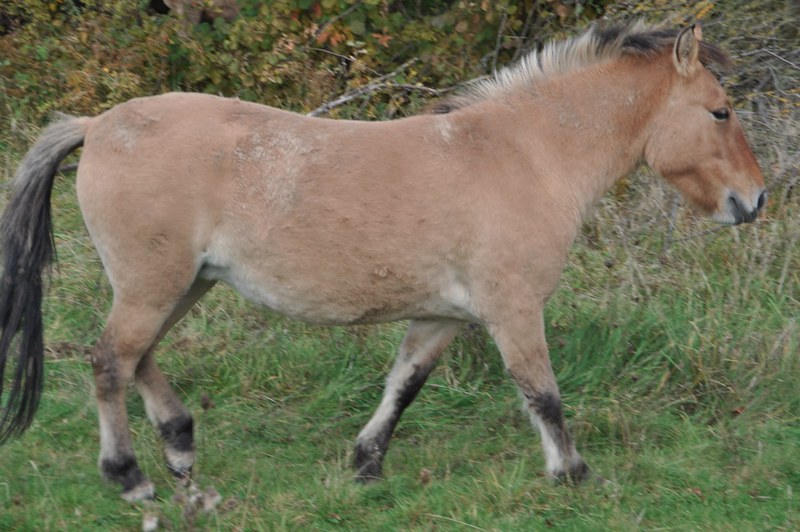The ecologic niche of the aurochs and where it differed from that of the wisent is hard to ascertain as the aurochs is extinct. Right? Not exactly. There actually a lot of things on the ecology of the aurochs and its interplay with other European herbivores that we can infer from various sources.

The aurochs and other European herbivores of the Holocene
1. The aurochs was a grazer and probably much like cattle ecologically
The aurochs had the hypsodont denture of a grazer, like cattle today [1]. Anton Schneeberger writes that aurochs fed on acorns, mown grain and hay they were provided, and on branches of shrubs and trees during winter [2]. It has been reported that aurochs grazed in the same places as cattle and horses [2]. Since cattle descend from aurochs, and domestication probably did influence the basic diet in cattle [2], it can be assumed that aurochs and cattle were very much alike in food choice. There are differences within cattle, but that is mainly between highly derived breeds and landraces, since the former do not consume plants that are less digestible while the latter do [3].
Isotope analyses suggest that aurochs were found in more forested and wetter habitats than cattle, which mainly grazed on pastures [1]. It is of course possible that this is a difference between the wildtype and the domestic form, but it is more likely that the aurochs was pushed into these less accessible regions because open habitats were reserved as pastures for domestic cattle. Also, free-roaming cattle have been found to prefer wet habitats as well [5]. The continuous habitat loss was one of the driving factors for the aurochs’ extinction [2].
2. The aurochs preferred lowlands and wetter habitat than the wisent
The distribution of fossil and subfossil remains of aurochs and wisent have shown that aurochs preferred plain habitat and lowlands while wisent were found much more often in mountainous habitat [4]. This is also in line with what is known of the historic distribution of both species [2]. While it is true that both the wisent and the aurochs have been limited to hideaway regions due to habitat loss because of the human civilization and hunting, it probably has a reason why the hideaway regions of aurochs were marshes and lowlands and that of the wisent was mountainous habitat, and this region were the ecologic adaptions of the respective species. The wisent avoids areas which are too wet [4], which is why a replacement of the cattle at Oostvaardersplassen with wisent, as it has been discussed on occasion, is not feasible (Bunzel-Drüke, pers. comm.)
Nevertheless, both bovines must have met each other [2].
3. There was niche partitioning among Europe’s large herbivores
According to the competitive exclusion principle in ecology, two or more species cannot exist in one and the same ecologic niche. Therefore, there must have been niche partitioning among Europe’s large herbivores and apparently this was the case. Cattle consume more wooden material than horses, which are strict grazers. However, cattle do not include as much wooden material in their diet as the wisent, which is a so-called semi-intermediate feeder. So there is a graduation on how much the respective herbivore relies on either grasses or wooden material, with horses relying the most on grasses and wisents consuming the most wooden material, and cattle being intermediate [4]. Since this niche partitioning is the result of evolutionary adaptions of these species, it is likely that this would also be the niche partitioning between wild horse, aurochs and wisent.
Therefore, considering the differing habitat and food preferences, cattle and wisent would concur only to a limited extent in Europe’s nature systems. So the fear that wisent and cattle cannot be kept in the same reserve is baseless as long as the reserve provides habitats for both species. Another reason why some people have objections against (re)introducing cattle into European nature systems is that they are concerned that wisent and cattle would hybridize. However, a work by Frans Vera has concluded that cattle and wisent do not hybridize spontaneously and only under artificial conditions, which also often lead to the assault of the domestic individual by the wisent [6]. Furthermore, parturition does not occur in those hybrid pregnancies [6], what makes human assistance necessary. Thus, cattle and wisent would not produce hybrid populations in the wild even if mating between both species would occur.
[1] Lynch et al.: Where the wild things are: aurochs and cattle in England. 2008.
[2] van Vuure: Retracing the aurochs – history, morphology and ecology of an extinct wild ox. 2005
[3] Poettinger, J.: Vergleichende Studie zur Haltung und zum Verhalten des Wisents und des Heckrinds. 2011.
[4] Bunzel-Drüke, Finck, Kämmer, Luick, Reisinger, Riecken, Riedl, Scharf & Zimball: „Wilde Weiden: Praxisleitfaden für Ganzjahresbeweidung in Naturschutz und Landschaftsentwicklung“. 2011
[5] Gander et al.: Habitat use of Scottish Highland cattle in a lakeshore wetland. 2003.
[6] Vera: Do European bison and domestic cattle hybridize spontaneously? 2002.



